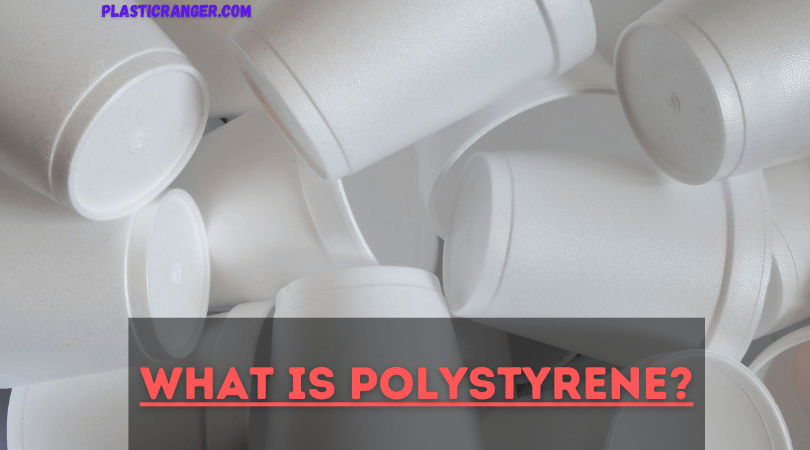Hello everyone, Polystyrene has been around for decades and is one of the most valuable thermoplastics worldwide, with applications in automotive, packaging, electronics, etc. Let’s get started with a detailed analysis of the infamous plastic material.
What is Polystyrene?
Polystyrene is a naturally transparent and synthetic thermoplastic extracted from a styrene monomer.
It is typically available in two forms – Solid Plastic and rigid foam material. Its main characteristic includes softening when applied to heat, and its films and sheets can be transformed into various products used in different applications.
It is one of the largest plastic commodities in market size (holding approximately 7% of the global thermoplastic market).
The solid plastic form of PS is primarily used in medical and healthcare applications like Petri dishes, test tubes, electrical and electronics appliances, containers, automobiles, healthcare, CDs, smoke detectors, etc.
Talking about the foam form of PS, It also has a wide array of packaging and consumer goods applications.
You must have noticed white foam custom packaging whenever you bought a new television or any other sizable electronic product (That foam packaging is made from polystyrene foam).
The chemical structure of polystyrene gives it unique physical and mechanical properties, such as transparency, rigidity, and lightweight.
How is PS Made?
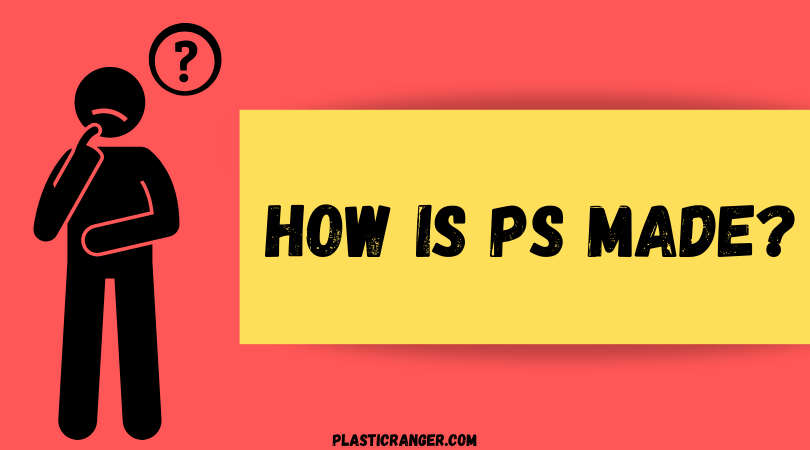
Like other thermoplastics, PS is made by filtration of hydrogen fuels into lighter groups called “fractions.” Some of those fractions are blended with certain catalysts through the polystyrene, called polymerization. PS foams are made by “Blowing agents” that enlarge or lengthen and shape the foam so that it can trap air.
Polystyrene Manufacturers
Here are the largest and most prominent PS manufacturers in the world:
| Company |
Country of Origin
|
| Chi Mei Corporation | Taiwan |
| Kumho Petrochemical | South Korea |
| INEOS Styrolution | Germany |
| SABIC | Saudi Arabia |
| BASF | Germany |
Fundamental Properties of PS Plastic
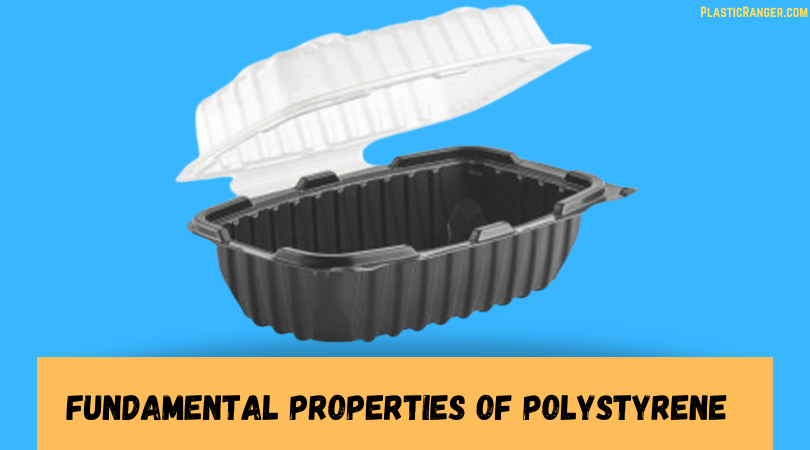
Adding additives and specific chemical agents with PS is a standard practice to enhance some of its weaker properties. For example – PS can be blended with methyl methacrylate to achieve higher clarity and better chemical and UV stability. However, one should keep a note that the blend makes yellow products.
Another good example is poly(styrene-co-butadiene) (SBR, SBS) and poly(styrene-co-acrylonitrile-co-butadiene) (ABS). All the blends boast high impact and stress strength.
It is often copolymerized with a monomer with an alternating structure to increase polystyrene’s heat resistance.
- Lack of crystallinity makes PS optically transparent.
- PS is an excellent electrical insulator with good chemical resistance against diluted acids and bases.
- Poor resistivity towards hydrocarbon solvents, oxygen, and UV
- Meager impact strength due to firmness in the polymer’s backbone
- The maximum temperature limit for prolonged or continuous use is limited due to lack of crystallinity and low glass transition temperature (Tg = 373 K (100°C))
- Medium to high tensile strength and low impact strength
- The density of polystyrene can vary between 0.96 to 1.05 g/cm3 and 28 to 34 kg/m3, depending on factors such as molecular weight, crystallinity, and processing conditions.
Below are the general properties of PS Plastic and foam:
| Property | Value |
| Tensile Strength |
53 MPa (7700 PSI)
|
| Melt Temperature |
210-249 °C (410-480 °F)
|
| Heat Deflection Temperature (HDT) |
95 °C (284 °F) at 0.46 MPa (66 PSI)
|
| Specific Gravity | 1.04 |
| Flexural Strength |
83 MPa (12000 PSI)
|
| Typical Injection Molding Temperature |
38 – 66 °C (100 – 150 °F)
|
| Molecular Weight of Repeat unit | 104.15 g mol-1 |
| Molar Cohesive Energy |
J mol-1 34200 – 37100
|
| Density |
g mL-1 1.05 – 1.06
|
| Entanglement Molecular Weight |
g mol-1 13600 – 17500
|
| Solubility Parameter | 18.5 – 19.4 MPa |
Disadvantages of Polystyrene

- High Flammability. It should be handled carefully
- Recycling is possible but is very expensive
- Harmful to environment
- EPS, due to its low density, fills a large amount of space in landfills.
Interesting Read – How is Plastic Made? A Simple and Detailed Explanation.
Commercial Polystyrenes
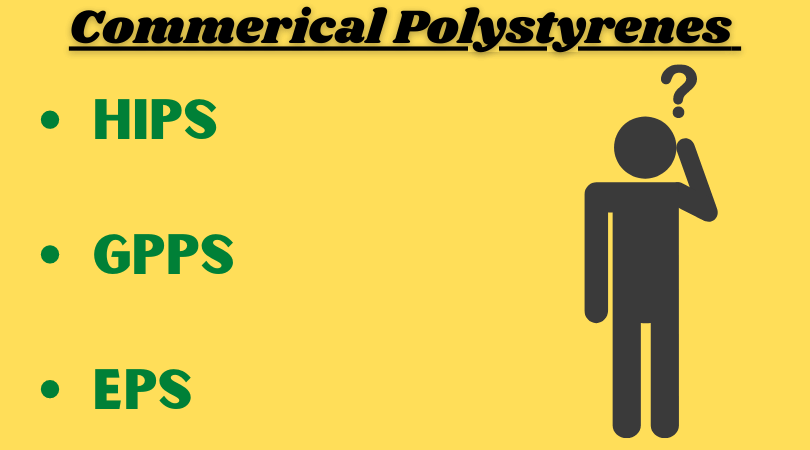
There are three main grades of polystyrene used worldwide.
- HIPS
- GPPS
- EPS
HIPS
High-impact polystyrene is a thermoplastic boasting high impact strength. It is comprised of 5 to 10 rubber. HIPS is a graft copolymer with polystyrene sidearms. The grafting occurs when some of the radicals start reacting to the double bonds of the polybutadiene.
GPPS
General-purpose polystyrene is a crystal clear polymer, rigid and somewhat brittle, and an in-expensive thermoplastic extracted from styrene monomer. GPPS is solid form plastic that is usually manufactured in the form of 2-5 mm pellets.
EPS
Expanded Polystyrene comprises beads commanded by pentane( the blowing agent). EPS is widely utilized in packaging applications and boasts good processability, high impact resistance, and thermal insulation.
Styrofoam™
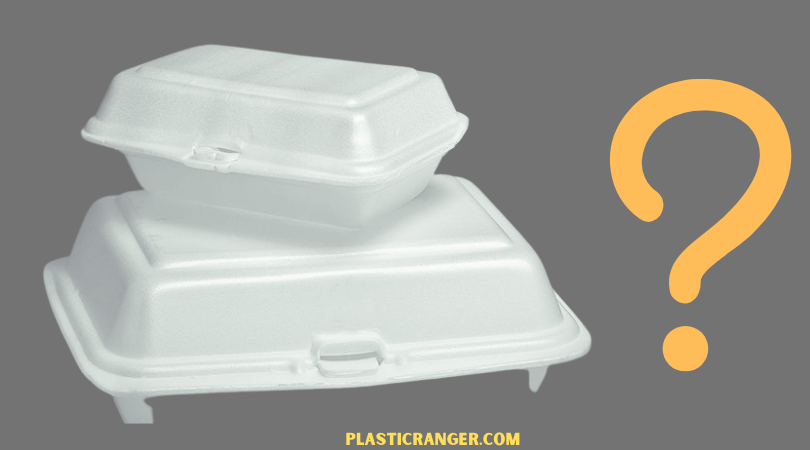
Styrofoam is a Dow chemical company trademarked closed-cell extruded polystyrene foam (XPS) brand. It is also known as “Blue Board,” manufactured as a continuous foam building insulation board extensively used in walls, foundations for thermal insulation, and water barriers.
The material is usually light blue. It is most prevalent regarding applications in the United States and Canada.
It comprises 95% air, making it unsinkable and capable of marinating its form for a prolonged time.
Styrofoam is mainly utilized for manufacturing containers, packaging materials, and coffee cups.
The branded polystyrene foam is categorized by its roughness and the type of “crunch” it makes while being cut. It has moderate soluble properties, mixing with many organic solvents, cyanoacrylate, and propellents.
Applications

PS Plastic and foams have many applications making our day-to-day life very easy. Here are they:
Automotive Applications
Thermoplastic’s utilization in automotive has increased substantially over the years; Polystyrene is no different. Both foam and solid variations are used for manufacturing knobs, instrument panels, trims, sound-dampening foams, energy-absorbing door panels, and child-protective seats used in cars and trucks.
Insulation Applications
Good thermal insulation properties are a must for insulation uses, and lightweight polystyrene provides remarkable insulation properties, making it apt for applications like refrigerators, freezers, building walls & roofing, cold storage facilities, etc. Polystyrene insulation moves less, is resistant to water damage, and is durable.
Appliances Applications
PS foam and solid form don’t react with materials, are cost-effective, and are used in electronic appliances like air-conditioners, coolers, ovens, blenders, vacuum cleaners, etc.
Electronics Applications
Polystyrene foam and plastic can play an integral role in a product’s aesthetic integrity; thus, it is also used in appliances like computers, televisions, routers, and printers.
Packaging Applications
The packaging is the most significant PS foam consumer thanks to numerous food industry options – egg cartons, meat packaging, poultry trays, plastic cups, and vegetable container packaging. CD and DVD cases and other types of foam packaging are also used in the market.
Medical Applications
Its clarity and good sterilization properties make it quite popular in the medical sector for products like Petri dishes, diagnostic components, culture trays, test tubes, and medical devices.
Engaging Read – What is PEEK Material? | The Definitive Guide
Polystyrene Plastic Processing Conditions
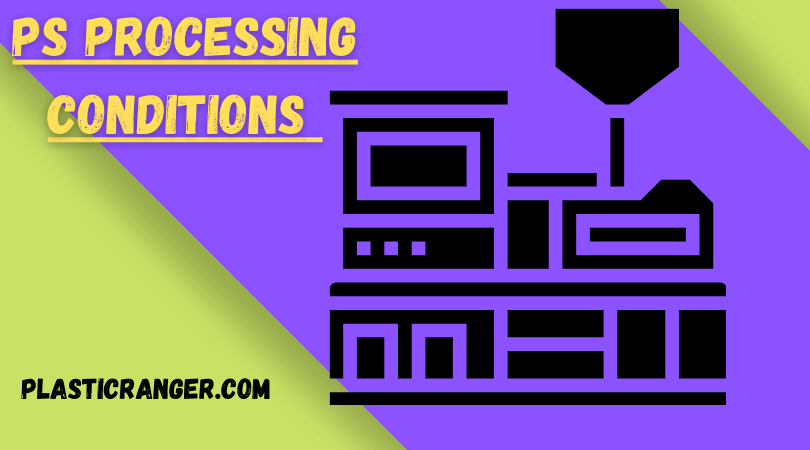
PS is best suited for injection molding due to its mechanical and physical properties. However, drying is unnecessary but should be done if stored improperly before processing. Here are the advisable processing conditions:
| The recommended speed is fast | Value |
| Drying |
If drying is required, the advisable conditions are 2 – 3 hours before professing at 80 C (176 F).
|
| Mold Temperature |
20 – 70 C (68 – 158 F)
|
| Melt temperature |
180 – 280 C (356 – 536 F)
|
| Material Injection Pressure | 20 – 60 MPa |
| injection Speed |
Recommended speed is fast
|
| Screw L/D Ratio | 20:1 |
History of PS Plastic

Polystyrene was invented in 1839 by Edward Simon, a medical professional from Berlin, Germany. He started by filtering an oily substance, a monomer made from Styrol(derived from storax).
I. G. Farben started the commercial production of styrene monomer in Ludwigshafen in 1931. They used it in many applications by successfully developing a reactor vessel that extruded polystyrene through a heated tube and cutter, producing PS in pellet form.
Fast-forward to 1954, the Koppers Company in Pittsburgh, Pennsylvania, developed a prototype foam under the trade name Dylite. That same prototype is now famously known as Expanded-polystyrene(EPS)
Fun Fact – Dart Container Corporation, the largest manufacturer of foam cups and containers, 1960 shipped the First polystyrene-made product order.
The Future of Polystyrene
According to a study conducted by Intrado GlobalNewsWire in 2019, polystyrene will register a CAGR of 4.87% from 2018 to 2023. PS plastic and foam will have a market value of over USD 33 Billion by the end of 2023.
Global Extruded Polystyrene Market, by region, 2018
The packaging industry is the largest and fastest-growing contributor to the PS market. The growing number of packaging applications and rapid growth in the E-commerce sector will continue the growth momentum for PS.
As you can see in the above chart, Asia-Pacific (thanks to China) is the market leader and, according to several analyses, will remain the market leader soon.
FAQs
Below are the frequently asked questions for PS plastic. Let’s dig deep to know more.
Why is polystyrene useful?
Polystyrene is the go-to packaging material thanks to its high compression, light, and coolness. It is more suspective snapping or collapsing but protects delicate objects if dropped. It is also a strong insulator, which can easily flow and accumulate electrical charge.
Is Polystyrene toxic to humans?
Polystyrene has long been considered to be toxic and unhealthy for humans. It contains two harmful substances called benzene and styrene. It has been proven that hot and liquid food can go through a partial breakdown, leaching certain impurities or toxins into your body.
What is the chemical name for polystyrene resin?
The chemical name is C 8 H 8. It is often regarded as the most used plastic.
Is Polystyrene polar or non-polar?
It is non-polar and can only be mixed with non-polar solvents. Because it is comprised of only carbon dioxide bonds.
What is the history of polystyrene?
Commercial production started in 1938, and within no time, it became extremely popular with manufacturers thanks to its low-cost production for large quantities, excellent processability with injection molding, and good mechanical, physical, and optical properties.
Which is better? Polystyrene Vs. Polyurethane?
Regarding equivalent thicknesses, polyurethane has a higher thermal insulation factor (R‑16 or RSI: 2.8) than polystyrene. In addition, as polyurethane adheres to door surfaces, it provides twice as much resistance as polystyrene in a comparable door.
Suggested Read
- What is Acrylic Plastic?
- What is Polycarbonate?
- Food Grade Plastic: The Best Plastics for Food Applications
- What is PET Plastic
- What is Bakelite?: The Plastic That Changed the World
- What is Polypropylene Material?
- What is PLA Plastic (Polylactide)? | A Simple and Definitive Guide
Summary
Polystyrene is a flexible polymer widely used in various industries, such as electronics, construction, and packaging, due to its exceptional features such as lightweight, rigidity, and transparency. Nevertheless, it is necessary to recognize that its utilization may result in environmental concerns, leading to the development of more sustainable substitutes.
Thus, comprehending the properties and potential environmental effects of polystyrene is essential to making informed choices about its use and identifying viable alternatives.
Kindly share your reviews in the comment box.
Quick Navigation

